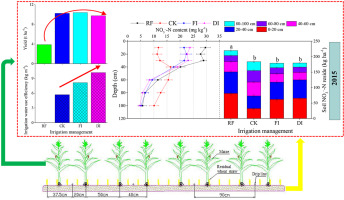Journal of Cleaner Production ( IF 9.7 ) Pub Date : 2020-03-26 , DOI: 10.1016/j.jclepro.2020.121279 Shicheng Yan , You Wu , Junliang Fan , Fucang Zhang , Kyaw Tha Paw U , Jing Zheng , Shengcai Qiang , Jinjin Guo , Haiyang Zou , Youzhen Xiang , Lifeng Wu

|
No-tillage with limited supplementary irrigation is promising for improving crop growth and ensuring sustainable crop yield in semi-arid and semi-humid areas defined by their water scarcity and uneven seasonal precipitation distribution. Choosing effective irrigation methods and scheduling to improve irrigation water use efficiency (IWUE) and reduce the risk of soil nitrate leaching has become increasingly necessary for crop management. Field experiments were conducted on no-tillage summer maize over four consecutive years from 2014 to 2017 in a semi-humid and drought-prone region of Northwest China. Four irrigation strategies were used, i.e. rain-fed (RF, no irrigation), conventional flood irrigation (CK), full drip irrigation (FI) and deficit drip irrigation (DI, 75% FI). The results indicated that supplemental irrigation mitigated the drought stress resulting in improving maize growth and a stable, sustainable yield. Plant height, leaf area index and aboveground biomass of the DI treatment were lower than those of the CK and FI treatments, while the DI treatment produced insignificantly lower grain yield and increased grain nitrogen content. The DI treatment promoted the transfer of nutrients from vegetative organs to reproductive organs. The IWUE of the DI treatment was increased by 22.1%–27.3% and 28.4%–48.6% compared with the CK and FI treatments during the four growing seasons, respectively. Soil NO3−-N of the CK treatment was mainly distributed below 40 cm soil depth, while most soil NO3−-N remained above 40 cm in the FI and DI treatments, implying lower levels of nitrate leaching compared with the conventional flood irrigation. In conclusion, deficit drip supplementary irrigation is a sustainable agricultural production strategy that improves water use efficiency, maintains stable yield and alleviates the risk of soil nitrate pollution in the no-tillage agrisystem of arid and semi-arid regions.
中文翻译:

免耕玉米系统中基于水分生产率和残留硝酸盐的可持续灌溉管理策略
免耕和有限的补充灌溉有望改善缺水和季节性降水分布不均的半干旱和半湿润地区的作物生长并确保可持续的作物产量。选择有效的灌溉方法和时间表以提高灌溉用水效率(IWUE)并减少土壤硝酸盐淋失的风险对于农作物管理变得越来越必要。2014年至2017年,连续四年在西北半湿润,干旱多发地区对免耕夏玉米进行了田间试验。使用了四种灌溉策略,即雨水灌溉(RF,不灌溉),常规洪水灌溉(CK),全滴灌(FI)和亏滴灌溉(DI,75%FI)。结果表明,补充灌溉减轻了干旱压力,从而改善了玉米生长,并实现了稳定,可持续的产量。DI处理的株高,叶面积指数和地上生物量均低于CK和FI处理,而DI处理产生的谷粒产量和氮含量却没有明显降低。去离子处理促进了营养成分从营养器官向生殖器官的转移。在四个生长季节,与CK和FI处理相比,DI处理的IWUE分别提高了22.1%–27.3%和28.4%–48.6%。土壤NO 而去离子处理产生的谷粒产量和氮含量却显着降低。去离子处理促进了营养成分从营养器官向生殖器官的转移。在四个生长季节,与CK和FI处理相比,DI处理的IWUE分别增加了22.1%–27.3%和28.4%–48.6%。土壤NO 而去离子处理产生的谷粒产量和氮含量却显着降低。去离子处理促进了营养成分从营养器官向生殖器官的转移。在四个生长季节,与CK和FI处理相比,DI处理的IWUE分别增加了22.1%–27.3%和28.4%–48.6%。土壤NOCK处理的3 -- N主要分布在40 cm以下的土壤深度,而FI和DI处理中的大多数土壤NO 3 -- N仍保持在40 cm以上,这意味着与常规的洪水灌溉相比,硝酸盐的浸出水平较低。总之,亏缺滴灌是一种可持续的农业生产策略,可以提高干旱和半干旱地区的免耕农业系统中的水分利用效率,保持稳定的产量并减轻土壤硝酸盐污染的风险。











































 京公网安备 11010802027423号
京公网安备 11010802027423号